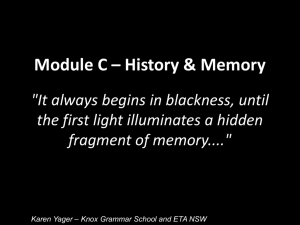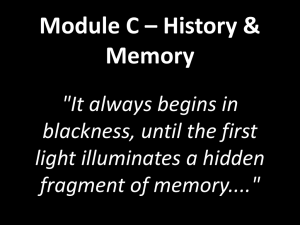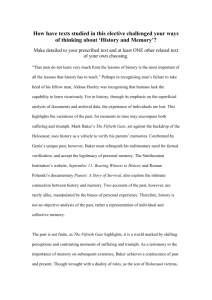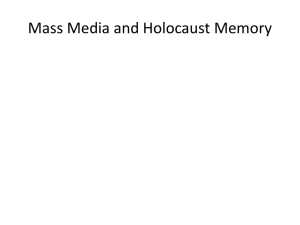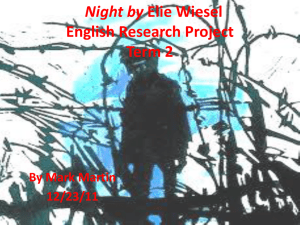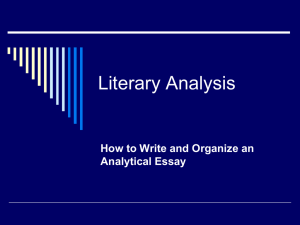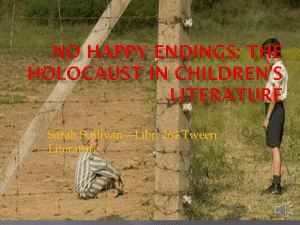Module C – History & Memory
advertisement
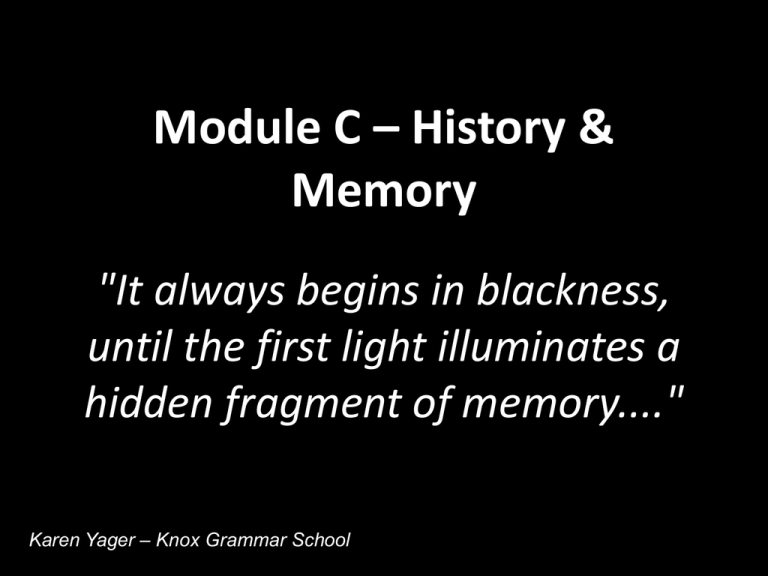
Module C – History & Memory "It always begins in blackness, until the first light illuminates a hidden fragment of memory...." Karen Yager – Knox Grammar School Conceptual Approach What have you discovered about humanity and life? What are your thesis statements? Rubric Representations of events, personalities or situations. Evaluate how medium of production, textual form, perspective and choice of language influence meaning. Relationships between representation and meaning. Rubric Relationships between individual memory and documented events. Analyse and evaluate the interplay of personal experience, memory and documented evidence How history and personal history are shaped and represented Marking Guidelines In your answer you will be assessed on how well you: demonstrate understanding of and evaluate the relationship between representation and meaning organise, develop and express ideas using language appropriate to audience, purpose and form Feedback from Marking Centre Many stronger responses demonstrated an awareness of the constructedness of texts and how the choice of form and its associated language features connected with the composer’s purpose and context. Skillful analysis and seamless integration of the prescribed text and well-chosen text Judiciously selected textual evidence In weaker responses, candidates superficially referred to aspects of history and memory. The Suggested Approach How the interplay of History and Memory are represented through an event and/or situation. How the act of representation – the form, medium of production and language - is shaped by the experiences, purpose and perspective of the composer. The ideas that are conveyed through the representation of the interplay. Representation The act – constructedness Purpose and intent Context Medium of production and form Language/filmic/visual /aural techniques Meaning conveyed Key terms from the rubric Medium of production: How is this text made? Is it filmed, written, drawn? etc Textual form: The text type of the work. Is it poetry? A novel? A short film? etc Perspective: The point of view being offered on the subject by the composer Choice of language: Language (or filmic, etc) techniques which help the composer to convey their message in this text. Medium: Comic Representation: Salient image of the fence Title: Signifying the Mouse Representation: Semiotics: striped uniform; large eyes – despair; hands open and pleading History & Memory Documented evidence locates and validates the event or situation in History. Memory transports the human experiences of this event or situation to the present. Memory is the beating heart of History. Interplay: symbiotic relationship; intrinsically linked; symphony; reciprocity; nuanced interaction Medium of Production & Form The text is non-linear, in keeping with the approach of Midrash, which comes from the Hebrew Darash meaning ‘to investigate’ - an investigation of the Biblical text in order to discover relevance and meaning in the present context. Bricolage of polyphonous interviews, documents and creative reconstructions. Bildungsroman: Development as a son – movement to understanding. Symbolism Stones: ‘Where once stood flower beds, barbed wire fences… and a concrete temple that beckoned almost one million Jews, there is grass, there are trees, and there are stones. Boulders are scattered throughout the field, hundreds of them, human forms in stony relief, each bearing the name of a village or city whose residents once visited this location.’ Binaries of light and dark. The Gates Imaginative Recreation ‘What are these papers anyway except echoes of the past, dark shadows without screams, without smells, without fear.’ Hinda’s final memories in a gas chamber. Evocative language and confronting gustatory imagery is used to describe the unbearable train trip to the death camp. ‘The air is mixed with the pungent odour of fresh vomit and faeces.’ Ominous metaphor as the guards begin ‘pushing the darkness of night into our vehicle’ to foreshadow the imminence of death paradox of ‘deafening screams’ Purpose & Context “Slowly, the book took on an entirely different shape: it became my journey into my childhood to try to understand what it meant to grow up in a household with so much sadness and tragedy. I mean, on the surface my parents laughed and loved; but there were all sorts of silences and coded signals which pointed to the terror of their own childhood” Baker. “I knew I had to take the same journey as my parents: to enter the darkness, so I could also come out laughing. I think of it as a candle flickering in a dim room. You only see the flame because there is darkness all around” Baker. Perspective Baker as an historian is sceptical of his mother’s stories as they cannot be confirmed by historical records. ‘Does history remember more than memory?…that I never believed her, that I only recognise suffering in numbers and lists and not in the laments and pleas of a human being, of a mother, screaming for acknowledgement?’ History History according to Hutchenson is faction or His/tory. It must always be questioned and examined to uncover who recorded the history and in what context. “Does history remember more than memory?…that I never believed her, that I only recognise suffering in numbers and lists and not in the laments and pleas of a human being, of a mother, screaming for acknowledgement?” History Unreliable and selective “There is no single, eternal, and immutable ‘truth’ about past events and their meaning” McPherson. George Orwell -1984: “Who controls the past … controls the future: who controls the present controls the past.” Personal vs. Public History Memory Our ability to store, retain, and recall information and experiences. Unreliable and selective; altered by experiences, such as trauma Process by which we make sense of our lives Cultural and personal history ‘Stories are the lifeblood of a nation’ Garth Boomer. Memory Vital to our understanding of the past. Most people derive their values, their sense of justice and sense of identity in this world, from memories of past events, situations and relationships with others. “A body of beliefs and ideas about the past that help a public or society understand both its past, present, and by implication, its future” Bodnar. Memory ‘It begins where it ends and ends where it begins: with my parents’ stories, and my stories of their stories, and now, their stories of my stories.’ ‘Come and see… The key is the forgotten heart, the murdered prayer, the death of memory. It opens the blessing or curse. Come and see. Memory ‘Dark, hiding in the cupboard it was all dark, while outside we could hear the footsteps, the shots, the screams.’ ‘Her story…her pain.’ P.89 - 94 – ‘Late at night they started to hit everybody, my sisters, me, they hit us all, but mainly they wanted my father.’ followed by the retelling of the history by Baker…’Prisoner Number 5503 informs the SS official in the Records Office that he is Leib Bekiermaszyn.’ Memory P. 107 – ‘I just can’t disconnect my past, you know, I can’t forget those moments for as long as I live.’ Genia: P. 185 -194, p.214, p.243-250 Yossl:p.224 P.314 - ‘We came from crematoria flames…from bunkers and from the woods…So always remember it, and your children will remember it. They will survive, they will sing and dance.’ “Let their memory be bound up in the bond of life.” Genia - Situation "[I]t was not the facts that were held under suspicion, but her credibility as a survivor. Unlike my father, she could never show her children the scars on her arm; hers were invisible, numbered in the days and years of her stolen childhood.“ “It was this uncontrollable urge, this repeated questioning of her, this interrogation, as if I was David Irving and not her son pointing the video camera at her.” Yossel - Event "My father is on pages forty-two and 109 of a Register of Jewish Survivors published by the Jewish Agency of Palestine in 1945…” “For my father, the rivers have not thawed, until now, when the words break out from their glacial silence, releasing a torrent whose flow runs backward into his darkest nights.?” ‘History burnishes particulars, brushes them clear of individual faces…everything personal, individual, is swept away in time’ Anne Roiphe, The Legacy of Memory. “Their stories were like the Siberian night sky as it appears now above the train, streaking starlight between spaces of darkness; and this is where their tales petered out, into an infinite darkness they called the Annihilation. They left a legacy of fragments, a jumble of jewels and ashes, and forests of severed family trees which their children now explore and try somehow to rescue” (Arnold Zable, Jewels and Ashes, pp.23-24). Symbiosis “Even more corrosive is the desire to forget. History needs memories to avoid the risk of forgetting crimes that must not be forgotten, victims whose suffering cries less for vengeance than for narration” Einstein. Creating a dialogue between memory and history connects the personal and social experience. History helps situate memory. Memory contributes to contextualising historical discourse. Event The Holocaust was the murder by Nazi Germany of six million Jews. Between 1941 and 1945, the Nazis established six extermination camps in former Polish territory-Chelmno, Belzec, Sobibor, Treblinka, Auschwitz-Birkenau and Majdanek. Holocaust: Related Texts Picture Books: Rose Blanche, Erika’s Star, Star of Fear, Star of Hope Films: Jacob the Liar, Schindler’s List, Pianist: A story of survival, The Reader Web Sites: www.remember.org Anne Frank’s Diary Night – Eli Weisel The Hare with Amber Eyes Fig Tree – Arnold Zable Maus Music: http://fcit.usf.edu/HOLOCAUST/resource/music.htm Poetry: http://www.datasync.com/~davidg59/holo_art.html The Book Thief – Marcus Zuzak After The Holocaust – G.F.Alford Chagall’s ‘White Crucifixion’, Jan Komsky’s paintings http://www.english.illinois.edu/maps/holocaust/art.htm Unable to Work by David Olère Chagall’s ‘White Crucifixion’ Jan Komsky’s ‘Round-up’ We saw the spirit of the Holocaust in Cambodia, in Tamil, in Kashmir, at My Lai. Wherever there is a refugee camp, faces pressed against the wires, the Holocaust is there” (Anne Roiphe, ‘The Legacy of Memory’). Situation “It doesn′t need to be six million deaths for me to respond now. I′ve learned to break down the pain into a different kind of equation: one plus one plus one. It doesn′t matter if it′s Rwanda, or Bosnia, or even just a homeless child, a single starving refugee. It′s a question of redirecting the rage on behalf of others so it doesn′t fester inside. Being a child in war…” Baker. A victim of war or persecution A child of survivors of a traumatic, tragic situation Incarceration Genocide Humanity’s inhumanity Related texts Kim Phuc – Vietnam Stolen generation: Archie Roach; Ruby Hunter/Rabbit Proof Fence Hotel Rwanda, The Killing Fields, Apocalypse Now Paintings: Picasso’s ‘Guernica’, Dali’s ‘Premonition of Civil War’ One Day in the Life of Ivan Denisovich War poetry: Wilfred Owen, Bruce Dawe, Siegfried Sassoon Related texts Nam Li’s The Boat Songs: ‘Only 19’, ‘Sunday Bloody Sunday’ Amnesty International advertisement ‘Child Soldiers’ Poem: ‘Siem Reap, Cambodia’ – Greg Santos The Cellist of Sarajevo – Steven Galloway Before stepping into a taxi a young girl struggles to take the city with her: Warm, sticky air bathing the street market, comforting scent of fragrant rice, pungent odour of dry fish, raw flesh hung on butchers' hooks, squawking of chickens in rusty wire prisons, crescendo of rickshaws, scooters, bicycles; the city she will no longer call home. As she speeds away, the city recedes into memory, as does the rolling countryside, once dotted by women tending to the paddies, children splashing among water buffalo. Now, echoes of distant missiles pierce her memories, murders of crows dive into reddened fields. The faces of Angkor watch sadly as their city crumbles, as another one of their children flees, taking nothing with her but me, gently growing inside. Dali’s ‘Premonition of Civil War’ Ideas Loss of innocence Storied existence Post-traumatic stress disorder/Depression Flawed humanity Courage in the face of adversity Loyalty Loss of faith and hope Chance Resilience Hope Response Conceptual understanding: - The thesis or line of argument - In response to the question - The framework and drivers for extended responses - Integrates the response - Support and challenge Developing a Thesis Strong opening paragraphs that introduce clear lines of argument or theses that directly address the question. A response that is driven by a thesis connected to the question. Each successive point must further the thesis through textual analysis and support. Support or even challenge then thesis through the analysis of the text/s. Precise topic sentences that are connected to and build on the thesis. Theses Overarching through the question to specific lines of arguments. Supporting the thesis with the reasons why the student has arrived at this point of view. At least two – three supporting arguments used to further the thesis that addresses the question in the essay. Representation – History/Memory interplay – event or situation ideas Suggested Approach Thesis related to an event or a situation that has been represented through the reciprocal relationship of History and Memory, and what this representation conveys about individual experiences in the past. Representation is shaped by the composer’s perspective that is in turn influenced by experiences, context and purpose. Although history and memory are fallible, when they are layered together, the past is illuminated and transported to the present. Lived human experience resonates inviting understanding and even empathy. Use the event of the Holocaust or a situation to frame the response. Find memorable examples of memories in the texts of the event or the situation. Discuss how the form and the medium of production have determined the language features and shaped the representation. Integration Making connections between the texts through: - Furthering or challenging - Act of representation - Event/Situation - History/Memory Connecting words: Furthermore, alternatively… In exploring the complexities between history and memory, it becomes evident that no matter how close we get to the historical truth of events, only memory can attempt to bring us closer to the reality of tragedies that confound representation. This idea is represented in Mark Baker’s biographical memoir, The Fiftieth Gate, Roman Polanski’s film, The Pianist, as well as Polanski’s documentary on the making of the film, A Story of Survival. In these three texts, history creates a context and a foundation for the understanding of the Holocaust. However, history is not enough to convey the reality of the experience, therefore the composers turn to memory to provide their audiences with an emotional understanding. History, the process of documenting events, has traditionally been represented as the authoritative, public and hierarchical representation of specific events. However, increasingly history has been perceived as a ‘construct’ rather than an absolute ‘truth’. The postmodern era has seen a proliferation in new forms of discourse leading to a democratization of the ways in which history is recorded. Memories, our personal recollections of the past, have been increasingly valued as a means of complimenting and validating recorded history, leading to a powerful and symbiotic interplay. Although filtered through time memories offer a highly emotive and subjective representation of specific events, personalities and situations. Although history is perceived to be more credible than memory, in actuality, both the former and the latter act as an interdependent and interconnected continuum in which they aid in the verification of the credibility of particular situations. Both Mark Baker through his text The Fiftieth Gate, as well as John Pilger’s documentary titled Year Zero: The Silent Death of Cambodia, through literary, audio and visual means of representation, exemplify not only the abhorrence of genocide, but also the concept that history and memory act in a symbiotic relationship, amplifying the stark and confronting reality of these situations. Theses History can be seen as the documentation of the past, however, there will always be contrasting perspectives and interpretations of any one event. In order to truly understand the past, we must fuse our knowledge of documented evidence with the personal experiences and memories that fill the gaps left by history. Whilst history attempts to replicate the authentic, memory adds a sense of similitude and emotional gravity to a historical event. Through Fiftieth Gate as a lens, Baker explores the limitations of post-factum representations in the transcendence of the Holocaust experience, relying on memory as a way of bridging post-memory with reality.
